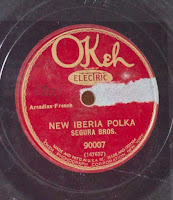 Lionel Cormier began learning the accordion from his father, Arvilian, at an early age. By the age of 12 he was playing the accordion for family gatherings and house dances in the Acadia Parish region. After marriage and a move to Gueydan, in 1935, he settled in Elton where he continued to play the accordion, mainly at house parties and family gatherings. After playing a few dances following World War II, he joined Percy Fuselier in 1947 to form the Elton Playboys. Within a couple years he regrouped and headed the Sundown Playboys.2
Lionel Cormier began learning the accordion from his father, Arvilian, at an early age. By the age of 12 he was playing the accordion for family gatherings and house dances in the Acadia Parish region. After marriage and a move to Gueydan, in 1935, he settled in Elton where he continued to play the accordion, mainly at house parties and family gatherings. After playing a few dances following World War II, he joined Percy Fuselier in 1947 to form the Elton Playboys. Within a couple years he regrouped and headed the Sundown Playboys.2Tu m'as quitte, pour t'en aller,T'en aller avec un autre,Moi, j'connais, merite pas ça,Ça ta fais moi a pas longtemps.Moi, j'ma va, mais, mon tout seul,P'us personne, mais, pour m'maimer,Moi, j'connais ça fais la peinne,Moi, j'connais merite pas ça, mais, malheurese.
 |
| Wallace Touchet, Lesa Cormier, Lionel Cormier, Orsy "R.C" Vanicor, Howard Mire |
Named after a popular dancehall in Acadia Parish, the "Welcome Club Waltz" (#1037) recorded in 1952, was named after the Welcome Club located in Crowley, Louisiana. Opened in the 1930s as the Delta Club, it hosted blues and jazz musicians throughout the 1940s. In 1951, Feature record producer, J.D. Miller, jumped into business with Welcome Club managers Henry Magnon and Leo Miller as part owner. The use of the club's name made sense, because it was one of many places Miller kept his jukeboxes playing his store's Feature records. Lionel's recording contained a melody similar to a version of "La Valse de Grand Chenier" and the old Creole tune "T'es Petite et T'es Mignonne". It's quite possible it also inspired Lawrence Walker's "Reno Waltz". By the late 1950s, the popular place became Club L'Acadien and remained that way for years.
You left me, you went away,
You went away with another,
I know I don't deserve that,
That you've done not long ago.
I'm going, well, all alone,
Nobody, well, to love me,I know that it hurts me,I know I do not deserve that, well, oh my.
 |
| Crowley Daily Signal May 13, 1955 |
The early band featured Lionel on accordion, Emory Lapoint on guitar and vocals, John Darbonne on drums, and Percy on fiddle. Darbonne played a short while and was replaced by Lionel’s son, Lesa. Also, Orsy Vanicor played the steel guitar for a while in late 1948, until he joined his family in Lacassine to play with Iry Lejeune and the Lacassine Playboys. Larry Miller from Iota replaced Vanicor on the steel guitar, and during 1949 Percy left the band and was replaced by Jake Bertrand. As personnel changed, Lesa renamed the band, the Sundown Playboys.2 By the time the band was in Miller's studio, it featured Howard Mire on guitar and vocals, Wallace ‘Red’ Touchet on fiddle, Larry Miller on steel guitar, and Tan Benoit on drums. Howard would continue on as a side musician with other Cajun artists such as Joe Falcon, Nathan Abshire, Lawrence Walker, Lionel Leleux, Don Montoucet, Blackie Fruge, Dick Richard, and his brother Jake Miers.

Lionel was successful in landing radio airplay including places like KPLC in Lake Charles, KSUL in Sulphur and KJEF in Jennings. In 1971, KJEF announcer Jerry Dugas hosted a show at the Bamboo Club on Highway 14. The highlight of the event was not the music, but an unforeseen event. While Lionel Cormier and the Sundown Playboys were preparing to play, Lionel had a massive heart attack, fell to the bandstand, and died while Jerry was making announcements.2
- Slim Harpo: Blues King Bee of Baton Rouge By Martin Hawkins
- Cajun Dancehall Heyday by Ron Yule
- Lyrics by Stephane F
Find:
Acadian All Star Special - The Pioneering Cajun Recordings Of J.D. Miller (Bear, 2011)



























